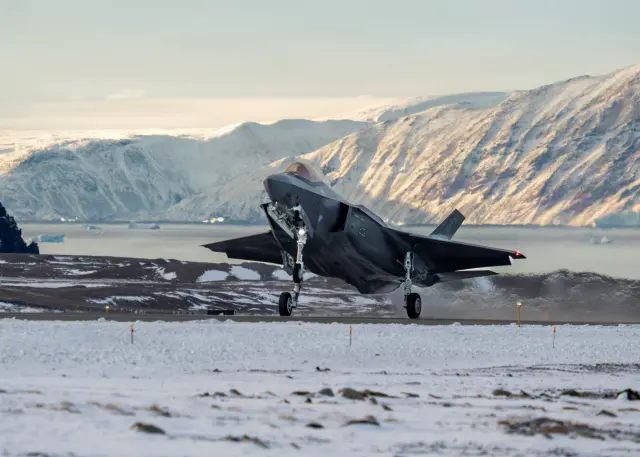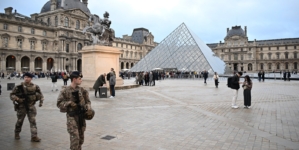-
The Crucial Lesson of a Forgotten Nixon-Era Episode - 27 mins ago
-
76ers Make Final Call on Joel Embiid’s Playing Status vs Lakers - 33 mins ago
-
How to Watch Texans vs Chiefs: Live Stream NFL Sunday Night Football, TV Channel - about 1 hour ago
-
Hundreds Rally for Boy, 6, Who Was Separated From His Father by ICE - about 1 hour ago
-
Rare Books Damaged In Water Leak at The Louvre Months After Heist - 2 hours ago
-
Trump Set to Host the Kennedy Center Honors - 2 hours ago
-
Southwest Airlines Avoids $11M Fine for 2022 Holiday Travel Meltdown - 2 hours ago
-
Bessent Says He Divested From Soybean Farms After Ethics Office Warning - 3 hours ago
-
Colts Coach Offers Bleak Injury Update on Daniel Jones After Jaguars Game - 3 hours ago
-
Immigration Agents Target Family of Deported College Student - 3 hours ago
US Flexes Arctic Air Power in Greenland
The United States deployed fighter jets to Greenland earlier this month, demonstrating its ability to rapidly move forces amid growing geopolitical competition in the Arctic.
The exercise highlighted the critical role of Greenland—an autonomous territory of NATO ally Denmark that President Donald Trump has repeatedly expressed interest in acquiring—in the defense of North America, the U.S. military said on Wednesday.
Why It Matters
The melting Arctic, which borders the U.S. and its NATO allies as well as Russia, is fueling a global contest over energy resources and new shipping routes. Last year, the Pentagon released an Arctic strategy amid cooperation between Russia and China—America’s ‘great power’ competitors—calling for an increased military presence.
The U.S. military has conducted multiple activities across the broader Arctic region to demonstrate its strength in recent months, including the deployment of a command aircraft designed to support nuclear forces to Greenland and joint maritime operations with Canadian forces near Russia’s Far East to address “emerging Arctic threats.”
Newsweek has emailed both the Russian and Chinese foreign ministries for comment.
What To Know
The U.S. Air Forces Northern conducted a dynamic operational exercise with Denmark from October 7 to 11 at Pituffik Space Base in Greenland, which aimed to demonstrate what it called U.S. rapid deployment capabilities and a commitment to Arctic security.

Multiple U.S. Air National Guard units were surged to the northernmost U.S. military installation to test readiness and strengthen interoperability with Danish partners, under the coordination of the North American Aerospace Defense Command, or NORAD.
Deployed American military aircraft included two F-35 and two F-16 fighter jets, in addition to three KC-135 aerial refueling aircraft. All are assigned to Air National Guard units in Wisconsin and South Carolina and had left Greenland by October 11.
Meanwhile, Denmark deployed specialized aircraft and personnel for search-and-rescue support, described by the U.S. military as “a vital capability” in the Arctic environment, ensuring the safety of all participants during the exercise.
“This exercise demonstrated our ability to quickly and efficiently deploy forces to the Arctic, showcasing the adaptability necessary to operate in this unique and demanding environment,” U.S. Air Force Lieutenant General Luke Ahmann said in a press release.
Ahmann is the commander of the Continental U.S. North American Aerospace Defense Command Region-1st Air Force (Air Forces Northern and Air Forces Space), tasked with homeland defense, support of civil authorities and theater security cooperation.
According to the press release, the U.S. Northern Command has assumed responsibility for homeland defense with respect to Greenland since June. The large island was described as a “strategic location” and a vital part in the defense of North America.

The exercise was an example of ongoing efforts to bolster Arctic security and ensure NORAD’s ability to monitor and respond to potential threats, the press release noted, adding that the U.S., Canada, Denmark and Greenland contribute to collective security.
Canada is part of the binational command NORAD, which is responsible for aerospace warning of attack, aerospace control and maritime warning for North America.
What People Are Saying
The Continental U.S. North American Aerospace Defense Command Region-1st Air Force (Air Forces Northern and Air Forces Space) said in a press release on Wednesday: “NORAD … employs a network of space-based, aerial and ground-based sensors, air-to-air refueling tankers, and fighter aircraft on alert, controlled by a sophisticated command and control network to detect, deter, and defend against aerial threats that originate outside or within North American airspace.”
U.S. Air Force Lieutenant General Luke Ahmann said in a press release on Wednesday: “[The exercise] highlighted the strength of our partnership with the Kingdom of Denmark. We deeply value its collaboration and the critical support it provides, particularly the Royal Danish Air Force’s commitment to search and rescue capabilities in this region. Its partnership is essential to ensuring the safety and security of operations in the Arctic.”
What Happens Next
The U.S. is expected to enhance its defense posture in the Arctic with its allies. It remains unclear whether there will be an increased U.S. military presence in the region.
Source link
















